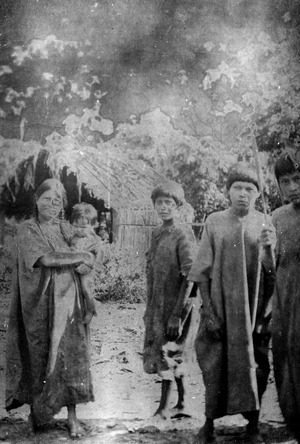Tsimané facts for kids

Photo taken in 1913 during Erland Nordenskiöld's expedition in Bolivia
|
|
| Total population | |
|---|---|
| 16,958 | |
| Regions with significant populations | |
| Languages | |
| Tsimané, Spanish | |
| Religion | |
| Traditional tribal religion | |
| Related ethnic groups | |
| Mosetén |
The Tsimané people, also called Chimane, are an native group living in the lowlands of Bolivia. Most of them live in the Beni Department. They are the main people living in the T’simane Council Territory and the Pilón Lajas Reserve. The Tsimané mostly grow their own food. They also hunt and fish a lot to get food for their communities.
Contents
Who are the Tsimané?
The Tsimané people are also known by other names like Achumano, Chamano, and Chimane. These are just different ways people have called them over time.
What Language Do They Speak?
The Tsimané speak the Tsimané language. This language is part of a small group called Mosetenan languages. Sometimes, it's even seen as a "language isolate," which means it's not clearly related to other languages. This is because some of its different forms are very similar to each other.
How Do They Live?
The Tsimané live in small villages. Each village usually has about 20 to 30 families. They mainly get their food by farming. They grow crops like bananas and manioc (a root vegetable) using a method called swidden agriculture. This means they clear a small area of forest, burn the plants, and then plant their crops in the rich soil.
Hunting, fishing, and gathering wild foods are also very important for almost all Tsimané communities. These activities provide a lot of their food. In recent years, some Tsimané have started to trade goods and earn money.
Tsimané Health and Lifestyle
Scientists have been studying the Tsimané people since 2002. They want to learn more about their health and how they live. One interesting finding is that Tsimané people do not seem to get heart disease as they get older in the same way people in many developed countries do.
Researchers have also looked at how the Tsimané sleep. They found that Tsimané people often work during the day and then gather around a fire in the evening. They share meals, stories, and information. Children and mothers usually go to sleep before the men. On average, they start sleeping about three hours after sunset. They typically sleep for about 5.7 to 7.1 hours each night. This is a bit less sleep than what many people in modern cities report.
See also
 In Spanish: T'simanes para niños
In Spanish: T'simanes para niños

